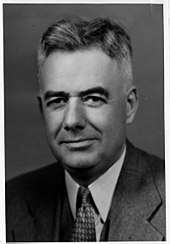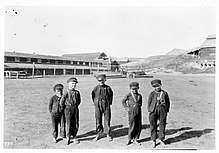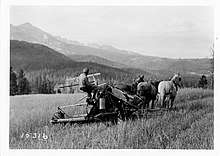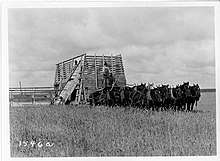M. L. Wilson
Milburn Lincoln Wilson (October 23, 1885 – October 1969) was an American Undersecretary of the U.S. Department of Agriculture (USDA) under Presidents Franklin D. Roosevelt and Harry S. Truman under the New Deal and Fair Deal. He made major contributions to US federal agricultural policies.[1][2][3]

He also directed the Subsistence Homesteads Division of the U.S. Department of the Interior before it was transferred to the Resettlement Administration.
Background
On October 23, 1885, Milburn Lincoln Wilson was born in Atlantic, Iowa, to John Wesley Wilson and Mary E. Magee.[1][3]
In 1907, he obtained a B.S. from Iowa State University. In 1920, he obtained an M.S. in agricultural economics and rural sociology from the University of Wisconsin at Madison.[1][2][3]
Career

In 1907, Wilson was a farmer. He arrived in Montana as a homesteader in 1909. By 1910, he began government service as Assistant State Agronomist at Montana State College at Bozeman (1910–1912), County Agent in Custer County, Montana (1912–14), Montana State Extension Agent Leader (1914–22), and extension agricultural economist again back at Montana State College (1922–24). In 1924, he joined the U.S. federal government, leading USDA's farm management and cost accounting (1924–1926). He returned again to the Montana State College as professor and head of the Department of Agricultural Economics (1926–33), during which period he advised the Soviets on large-scale wheat farming (1929).[1][2][3]
Wilson returned to federal service in 1933. From May to September that year, he served as the Chief Wheat Production Secretary in the newly formed Agricultural Adjustment Administration. From September 1933 to June 1934, he directed of the Subsistence Homesteads Division of the U.S. Department of the Interior. In July 1934, he became USDA Assistant Secretary. In 1937, he became USDA Undersecretary. In 1940, he became director of USDA's Extension Work as wells as Chief of Nutrition Programs and in the Production and Marketing Administration (1943–1949).[1][3]
Associations
Wilson was a member of the American Association for the Advancement of Science and of the American Farm Economic Association, the latter of which he served as president in 1925.[1][2][3]
Personal and death
Wilson was a Unitarian.[1]
On December 17, 1913, Wilson married Ida Morse of Cromwell, Minnesota.[1][3]
Wilson moved to Washington, D.C., where he was a member of the Cosmos Club.[1][3]
He died in Washington in October 1969. His grave lies in Rock Creek Cemetery.[1][3]
Legacy



Wilson contributed to public agricultural policy and programs designed with regard to drought, depression, and low income. His chief contribution was to help design the first U.S. federal agricultural commodity programs.[1][2][3]
In 1974, Montana State College (now Montana State University) established an annual M. L. Wilson Lecture, co-sponsored by the MSU Wilson Lecture Fund and MSU's Department of Agricultural Economics and Economics. Scholars address agricultural economics and economics issues related to the state.[2]
Awards
Works
Works by self:
- Milburn Lincoln Wilson Agricultural Photographs Collection, 1901-1945 Photographs[3][4]
- Report of Commission appointed to report on the Lethbridge northern and other irrigation districts in Alberta (1930)[5]
- Farm relief and the domestic allotment plan (1933)[6]
- Democracy Has Roots (1939)
- The rural home and the National emergency (1942)[7]
- Reminiscences of Milburn Lincoln Wilson : Oral History (New York: Columbia Oral History Research Office, 1956/1975)
Contributions to other works:
- The federal government today; a survey of recent innovations and renovations (1938)
- Thomas Jefferson. Papers read before the American Philosophical Society in celebration of the bicentennial of Thomas Jefferson, third president of the Society (1943)
- Studies of rural social organization in the United States, Latin America, and Germany (1945)
See also
- Agricultural Adjustment Act
- U.S. Department of Agriculture
- Franklin Delano Roosevelt
- Harry S. Truman
- New Deal
- Fair Deal
References
- Scott, Kim Allen (2009). "M. L. Wilson Collection, 1935-1960". Archives West / Orbis Cascades Alliance. Retrieved 28 May 2017.
- "M.L. Wilson Lecture". Montana State University. Retrieved 29 May 2017.
- "Collection 2581 - Milburn Lincoln Wilson Agricultural Photographs Collection, 1901-1945". Montana State University. 2007. Retrieved 29 May 2017.
- Wilson, M. L. Milburn Lincoln Wilson Agricultural Photographs Collection, 1901-1945 Photographs. Montana State University Library. Retrieved 29 May 2017.
- Wilson, M. L. (1930). Report of Commission appointed to report on the Lethbridge northern and other irrigation districts in Alberta. Edmonton: W.D. Mclean, King's printer. LCCN 42009888.
- Wilson, M. L. (1933). Farm relief and the domestic allotment plan. University of Minnesota Press. LCCN 33018649.
- Wilson, M. L. (1942). The rural home and the National emergency. US GPO.
External links
| Wikimedia Commons has media related to Milburn L. Wilson. |
- Bell, Jr., Edward J. (December 1968). "M. L. Wilson—Economist, Philosopher, and Man of Action". American Journal of Agricultural Economics. Cite journal requires
|journal=(help) - FDR Library M.L. Wilson Papers 1932, 1956
- USDA resources on Wilson
- Social Networks and Archival Context Wilson, M.L. (Milburn Lincoln), 1885-1969)
- Truman Libraary references to Wilson
- USDA Caricature of M.L. Wilson (1934)
- Truman Library M. L. Wilson photo (1965)